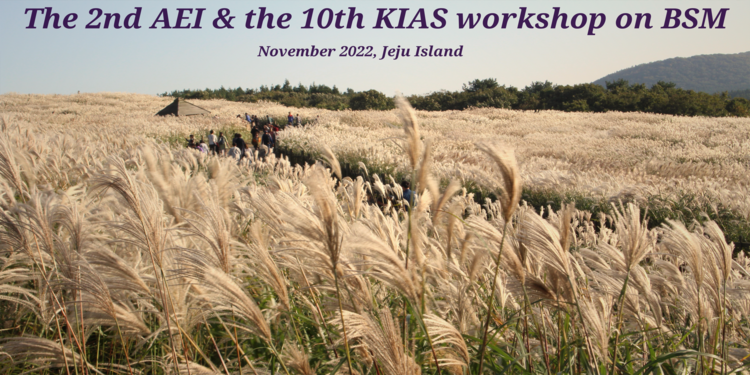- Indico style
- Indico style - inline minutes
- Indico style - numbered
- Indico style - numbered + minutes
- Indico Weeks View
The 2nd Asian-European-Institutes (AEI) Workshop for BSM and the 10th KIAS Workshop on Particle Physics and Cosmology
→
Asia/Seoul
The Grand Sumorum, Jeju
The Grand Sumorum, Jeju
114, Maksukpo-ro, Seogwipo-si, Jeju Special Self-Governing Province (1513, Beophwan-dong)
, , , , ,
Description

The 2nd “Asian-European-Institutes Workshop for BSM” will be held jointly with the 10th "KIAS Workshop on Particle Physics and Cosmology". This will be the first event in the series since the start of the COVID-19 pandemic.
The aim of this meeting is to gather theorists from participating institutes together to share their current research related to particle physics and cosmology, with a particular focus on BSM. Additionally, a number of overview talks from invited speakers have been organised to outline, and provide updates to, some broad classes of theoretical models. This joint workshop will provide opportunities for collaboration between researchers from different institutes, and help young researchers better promote themselves in the community.
The event will be held at The Grand Sumorum, Jeju Island between Nov. 13-18, 2022 (ending after lunch on the Friday).
Invited Speakers
AEI Workshop:
- Josh Eby (Kavli IPMU)
- Christoph Englert (Glasgow U.)
- Jason L. Evans* (T.D. Lee Institute, SJTU)
- Sungwoo Hong (U. Chicago, KAIST)
- Rachel Houtz (IPPP, Durham)
- Valya Khoze (IPPP, Durham)
- Jeong Han Kim (CBNU)
- Frank Krauss (IPPP, Durham)
- Hye-Sung Lee (KAIST)
- Shu Li* (T.D. Lee Institute, SJTU)
- Kyohei Mukaida* (KEK)
- Myeonghun Park (Seoultech, KIAS)
- Lauren Pearce* (Penn State U, New Kensington)
- Satoshi Shirai (Kavli IPMU)
- Minho Son (KAIST)
- Yufeng Wang* (T.D. Lee Institute, SJTU)
- Zhi-Peng Xing* (T.D. Lee Institute, SJTU)
- Ning Zhou* (SJTU)
KIAS Workshop:
- Priyotosh Bandyopadhyay (Indian Inst. Tech., Hyderabad)
- Sang Hui Im (IBS-CTPU)
- Chulwoo Jung (BNL)
- Hyun Min Lee (CAU)
- Seong Chan Park (Yonsei)
- Wan-Il Park (JBNU)
- Seodong Shin (JBNU)
- Jeonghyeon Song (Konkuk)
* Indicates an online talk.
Important notices:
- Deadline - Abstract submission: Oct. 23, 23:00, 2022 (KST).
- A number of rooms at the workshop hotel have been booked in preparation for the joint workshop.
Invited speakers will have their accommodation (including breakfast) covered by the workshop. Others who also wish to stay at the same hotel can find details of the costs on the registration page.
- Lunch and dinner will be provided gratis to invited speakers. Otherwise, a registration fee of 250,000 KRW for domestic participants, or 180 USD for foreigners will be charged to those who wish to attend the organised lunches and dinners (with the invited speakers). If you plan to explore the local restaurants yourself, you do not need to pay the registration fee.
- For those in need of financial support: please indicate this on the registration form. There are some limited funds for speakers with insufficient budgets.
Participants
Ahmed Hammad
Chandrima Sen
Christoph Englert
Chulwoo Jung
Dibyendu Nanda
Dong Woo Kang
Eung Jin Chun
Frank Krauss
Graham White
Hye-Sung Lee
Hyeonmo Koo
Hyun Min Lee
Jae Hoon Jeong
Jae-hyeon Park
Jaeok Yi
Jason EVans
Jeong Han Kim
Jeonghyeon Song
Jiheon Lee
Jongkuk Kim
Joshua Eby
Kyohei Mukaida
Lauren Pearce
Masahito Yamazaki
Meshkat Rajaee
MIHOKO NOJIRI
Minho SON
Myeonghun Park
Ning Zhou
Pankaj Saha
Pouya Bakhti
Priyotosh Bandyopadhyay
Pyungwon Ko
Rachel Houtz
Raymundo Ramos
Samuel Lane
Sang Hui Im
Sanjoy Mandal
Satoshi Shirai
Seodong Shin
Seong Chan Park
Shigeki Matsumoto
Shu Li
So Young Shim
Sumit Ghosh
Sungwoo Hong
Suro Kim
Tae Hyun Jung
Thomas Flacke
Tom Melia
Tomasz Dutka
Toshinori Matsui
Ui Min
Valentin Khoze
Wan-Il Park
Xiao-Gang He
Xing-Yu Yang
Yu Watanabe
Yufeng Wang
Zhi-Peng Xing
Zoom Meeting ID
85385309109
Host
KIAS HEP-PH Organizer
Zoom URL

